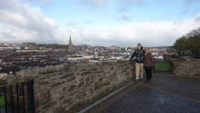 One of the reasons we travel is being there. It’s easier to understand why England was afraid of what was going on in France when you are in Dover and can see France just twenty-three miles away. You can understand why Venice was a maritime power when you are surrounded by water everywhere in the city. You can see why the Scots would flee to the remote Highlands when threatened by the English. And being in Derry, I was able to make a little more sense out of “The Troubles” and of the song “The Town I Loved So Well” and of the newer show Derry Girls.
One of the reasons we travel is being there. It’s easier to understand why England was afraid of what was going on in France when you are in Dover and can see France just twenty-three miles away. You can understand why Venice was a maritime power when you are surrounded by water everywhere in the city. You can see why the Scots would flee to the remote Highlands when threatened by the English. And being in Derry, I was able to make a little more sense out of “The Troubles” and of the song “The Town I Loved So Well” and of the newer show Derry Girls.
We got underway today about 10:00, starting with a tour of the mile-long circuit of the 350-year-old still-intact city walls. Meredith was narrating out of her usual trusty guidebook by Rick Steves. The walls are now a strolling place for anyone, but from the 1970s until about 2005, they were closed to the public, as the British patrolled the walls, especially to keep an eye on the Catholic Bogside area below the walled part of the city. More on that in a bit.
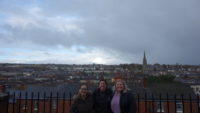 For those who don’t know or remember, “The Troubles” is a term used to describe the tension and violence that were in Northern Ireland between (mostly pro-Irish) Catholics and (mostly pro-English) Protestants. The Troubles were mainly active from 1970 or so to the late 1990s, with the British finally removing most troops by 2005 or so. Derry/Londonderry was a hotspot for the Troubles, but happily, peace has more or less been the norm for over twenty years now. May it long continue.
For those who don’t know or remember, “The Troubles” is a term used to describe the tension and violence that were in Northern Ireland between (mostly pro-Irish) Catholics and (mostly pro-English) Protestants. The Troubles were mainly active from 1970 or so to the late 1990s, with the British finally removing most troops by 2005 or so. Derry/Londonderry was a hotspot for the Troubles, but happily, peace has more or less been the norm for over twenty years now. May it long continue.
Anyway, we were a short way into our wall walk, and just beginning to learn about how the Catholic King James II laid siege to the Protestant stronghold of Derry, when it began to rain hard enough for us to think about inside options. We headed over to the Siege Museum, where we learned the story of the siege that was started when a group of young apprentice men took things in their own hands and shut the city gates on the approaching army, which sparked the will to resist from the town and started a 105-day siege by the English forces that was eventually commanded by the king himself. It was only broken when two relief ships managed to fight up the river to relieve the city, just before the twenty thousand people inside the walls, who’d been eating mice and rats and were on the brink of starvation, were about to capitulate.
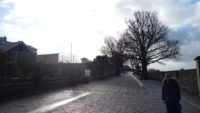 The Siege Museum also told of the Apprentice Boys Society, which is group of men who honor the defenders of the city. They organize a couple of marches each year in the city and sponsor the museum. The presentation was a bit pro-Union/Protestant, but still useful in starting to untangle the mass and mess of history that led up to the Troubles. Catholic King James II had to retreat and was defeated a year later in Ireland and was replaced by a Protestant king in England.
The Siege Museum also told of the Apprentice Boys Society, which is group of men who honor the defenders of the city. They organize a couple of marches each year in the city and sponsor the museum. The presentation was a bit pro-Union/Protestant, but still useful in starting to untangle the mass and mess of history that led up to the Troubles. Catholic King James II had to retreat and was defeated a year later in Ireland and was replaced by a Protestant king in England.
The rain had stopped by the time we left the museum, so we continued on our wall walk. It did have grand views of the surrounding hills (Donegal in the Irish Republic, just a few miles away), and of the memorial murals that were painted on Bogside (Catholic) houses in the 1990s. We got close-up views of the in-the-walls Protestant cathedral and enjoyed getting most of the way around. When we had just a couple hundred yards left in the wall walk, the rain returned, so we went into the Tower Museum, which had a permanent exhibit on the history of Derry, an exhibit on the excavation of a Spanish Armada ship from the nearby loch, and a temporary exhibit on the show Derry Girls, which has much to do with our being here.
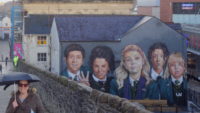 My brother had recommended the show to us a while ago, and our friend Meredith showed it to us. We loved it. It’s a comedy (of all things) about five teenagers going to school in the nineties in Derry during the Troubles. It’s brilliantly funny in many places, and poignantly serious in a few places. Since we hadn’t really done the Derry area on our previous trips, Meredith said she wanted to see Derry on this one. Because of the central location of the city for all things north on the island, we decided to stay here for four nights before finishing the week in Dublin.
My brother had recommended the show to us a while ago, and our friend Meredith showed it to us. We loved it. It’s a comedy (of all things) about five teenagers going to school in the nineties in Derry during the Troubles. It’s brilliantly funny in many places, and poignantly serious in a few places. Since we hadn’t really done the Derry area on our previous trips, Meredith said she wanted to see Derry on this one. Because of the central location of the city for all things north on the island, we decided to stay here for four nights before finishing the week in Dublin.
Anyway, the Tower Museum exhibit had sets and props and costumes from the actual show, and video interviews with the creator. Julia had seen the show, and so the three of us chuckled through the sets, and it made Sydney add it to her to-view list. Much fun.
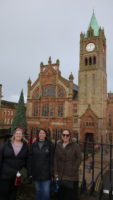 The museum wound us on a one-way route through the history of Derry, starting with the founding of a monastery in an oak grove (“Derry” seems to be related to the Irish word for grove), and continuing on to the town’s being an ecclesiastical center, to the town’s being sacked a few times by Vikings, to the town’s being razed by an Irish lord who had been pro-English until a change in policies ticked him off, to the area’s being settled as a “plantation” (a deliberate plan of foreign settlement), to the rise of the walled town, to the siege, to the debate about Irish Home Rule, to the creation of a Republic of Ireland and a separate Northern Ireland, to the Troubles, and to the peace of the last twenty years. Whew. It was fairly complicated, and a man to whom we talked in a pub called it whitewashed and simplified. I’d hate to see the hard history, then.
The museum wound us on a one-way route through the history of Derry, starting with the founding of a monastery in an oak grove (“Derry” seems to be related to the Irish word for grove), and continuing on to the town’s being an ecclesiastical center, to the town’s being sacked a few times by Vikings, to the town’s being razed by an Irish lord who had been pro-English until a change in policies ticked him off, to the area’s being settled as a “plantation” (a deliberate plan of foreign settlement), to the rise of the walled town, to the siege, to the debate about Irish Home Rule, to the creation of a Republic of Ireland and a separate Northern Ireland, to the Troubles, and to the peace of the last twenty years. Whew. It was fairly complicated, and a man to whom we talked in a pub called it whitewashed and simplified. I’d hate to see the hard history, then.
We went up to the top of the tower (of the Tower Museum), where we had a great vantage point to see the city, although the rain had smeared the safety glass all around the viewing area, so the sights were diminished a bit. We wound our way back down through four floors of the story of finding and excavating a Spanish Armada ship. I had not remembered that after the encounter with the English, the ships retreated east and north up around Scotland and then tried to go around Ireland, with many ships sinking along the way from the English navy or from running aground.
Back outside again, we ducked into a cute area with craft stores and had a late lunch at a cafe set in a recreation of a cottage. Good food in a pretty building with friendly staff made for a good repast.
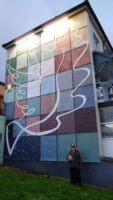 At my insistence, Meredith and Julia and I finished the last two hundred yards of wall walk while Sydney went home to rest for a bit. The three of us then walked down to Bogside to look at about ten murals commemorating issues around the Troubles. There were murals on peace, and some showing defiance, and some remembering the victims of Bloody Sunday (when fourteen unarmed people were shot by a British regiment who thought they were under fire) or innocent bystanders like a girl shot by crossfire. The murals are all large, with most taking up the end of a building. Along the way, we saw a memorial to ten men who died of a hunger strike while in prison, protesting for the right to be treated as political prisoners. We also saw a memorial to the victims of Bloody Sunday.
At my insistence, Meredith and Julia and I finished the last two hundred yards of wall walk while Sydney went home to rest for a bit. The three of us then walked down to Bogside to look at about ten murals commemorating issues around the Troubles. There were murals on peace, and some showing defiance, and some remembering the victims of Bloody Sunday (when fourteen unarmed people were shot by a British regiment who thought they were under fire) or innocent bystanders like a girl shot by crossfire. The murals are all large, with most taking up the end of a building. Along the way, we saw a memorial to ten men who died of a hunger strike while in prison, protesting for the right to be treated as political prisoners. We also saw a memorial to the victims of Bloody Sunday.
By then it was quite dark and cold, so we walked back to the B and B to regroup and get more clothing. We all then decided to go to the Guildhall, which acts as a town hall, which has an exhibit on the English plantation (settlement) system and how it failed to deliver on the ideal plan promised to investors (push out all the Irish, make a ton of money, and convert everyone to the Anglican church). The building itself was quite beautiful, and as an added bonus, we spent about twenty minutes talking to Lucy, a young woman from Derry. We chatted about the Troubles (they aren’t taught in the now-mixed Protestant/Catholic schools until seventh year) and Lucy’s studies (nursing) and about life in Ireland and in the US. She was friendly and kind, and I enjoyed talking to her.
We went to a pub for supper and with an eye out to playing a pub quiz at 9:00. Pub quizzes are trivia games, but are taken very seriously in the UK, and we thought it would be fun, even if we were terrible (we don’t get many UK pop references). It turns out that there was an important soccer match on tonight, so the pub quiz was pushed back to 10:00, which was way too late for us. But we got to talk to the man working in the pub who looked to be about our age. He had a terrifically thick accent, but with some context and concentration, I managed to follow most of what he was saying. He told us about Derry and growing up Catholic during the Troubles. We talked for about forty-five minutes before we excused ourselves and headed home for the night.
So between two museums, memorials and murals, boots on the ground, and two town natives of different ages, I now have a slightly better understanding of the Troubles and the history of Derry. That’s worthwhile, but so were the dozen or so interactions with very friendly people today. Understanding that people are people is a very worthwhile reason to travel.